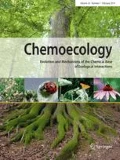Summary.
In a wind tunnel bioassay the effect of three concentrations of natural extracts of (1) Scots pine wood, Pinus sylvestris, and (2) larval frass on the behavioural response of unmated females and males of the old house borer, Hylotrupes bajulus, was tested and compared to the behavioural effects of the male-produced sex pheromone (3R)-3-hydroxy-2-hexanone. The influence on the behaviour of both sexes was found to be equally significant for the two higher concentrated hexane extracts of wood and larval frass. Therefore several synthetic monoterpenes present in the extracts and ethanol were tested at the two higher concentrations (1:100, 1:1000 vol/vol). Among the higher concentrated monoterpenoid hydrocarbons [(+)-α-pinene, (+)-β-pinene, (+)-limonene], only α-pinene increased the activity, orientation towards scent source and interest towards conspecifics. The tests with higher concentrated ethanol and the oxygenated monoterpenes [(-)-verbenone, (-)-trans-pinocarveol, (+)-terpinen-4-ol, (+)-α-terpineol, (-)-myrtenol] revealed that verbenone is the most effective stimulant for the females, followed by trans-pinocarveol, terpinen-4-ol and α-terpineol. For males, terpinen-4-ol was the only mediator significantly inducing attraction and orientation towards the scent source combined with an interest in conspecifics apparent by fighting or courtship behaviour. Males did not respond to verbenone which is a main compound of larval frass. Myrtenol and ethanol were ineffective in both sexes. In fact behavioural observations suggest that the beetles were repelled by the high dose of myrtenol. Using the ten-fold lower dose of the synthetic monoterpenes (1:1000 vol/vol), all semiochemicals except myrtenol lost activity. Myrtenol, however, induced behavioural responses, like increased activity and orientation towards scent source, only at the low concentration. Based on the results, primary attraction of unmated old house borer is probably mediated by monoterpenes of coniferous wood, while secondary attraction to infested wood would occur in response to volatiles of larval frass.
Author information
Authors and Affiliations
Additional information
Received 5 May 1999; accepted 30 September 1999
Rights and permissions
About this article
Cite this article
Fettköther, R., Reddy, G., Noldt, U. et al. Effect of host and larval frass volatiles on behavioural response of the old house borer, Hylotrupes bajulus (L.) (Coleoptera: Cerambycidae), in a wind tunnel bioassay. Chemoecology 10, 1–10 (2000). https://doi.org/10.1007/s000490050001
Issue Date:
DOI: https://doi.org/10.1007/s000490050001

